Updated for 2022
It is always at a very early age when people develop an interest in watching the sky and knowing what’s out there waiting for us to explore in outer space. It is very important as a parent to start nurturing this curiosity to help children understand our place in the universe and give them a sense of fraternity to the rest of the human race.
If you have a small kid that is only around the 3 to 5 years old range you might be wondering if it is a good idea to buy them their first telescope and if so, which one? is it going to be expensive? can they use it by themselves or do they need supervision?. We have all those answers and more for you in this article that will guide you through the whole process. You don’t need any experience yourself with telescopes, we will keep it simple and understandable.
If you want to directly skip to the telescope recommendations for five-year-old kids, click below:
Should kids 3 to 5 years old get a telescope?
Short answer: It depends.
While there are telescopes specifically designed for children, most of the “real” telescopes are designed for 8 years old and up as they will have the ability to set them up, they can understand how to use them and they know how to take better care of their stuff. For kids in the 5-year-old range and younger it gets a bit more complicated as you have two possibilities:
If you want them to use them by themselves then you are looking more in the category of toys rather than telescopes because there will be safety considerations to take. For example, the telescope can’t be too heavy or have too many moving or small parts. Telescopes that are designed with this simplicity in mind will be very limited in what they can do.
Another thing to consider is the useful life span of the telescope. Kid’s telescopes are cheap and are designed specifically so they can learn but they can be outgrown very quickly as they don’t have enough aperture or magnification to really look at objects beyond the moon and maybe a couple of planets. For this reason, we would recommend you to not invest too heavily at this point and stay in the under $100 range. Once your kid grows a little bit more, if they are still interested in learning more then you can consider getting a better telescope that will last you for a decade.
So, should you get your five-year-old a telescope?
- If you are interested in astronomy yourself and you have the time to supervise them and learn with them, go for it. Get one of the telescopes in the “real telescope” section. It will last you for a long time and you will be able to appreciate plenty of cool things in the night sky with it.
- If your kid is only 3 or 4 years old we’d actually recommend you to wait it out a couple years. Get one of the telescopes in the toy section or the scopes section. The exception to this is you want to get one for yourself and share it with them.
How to choose a telescope
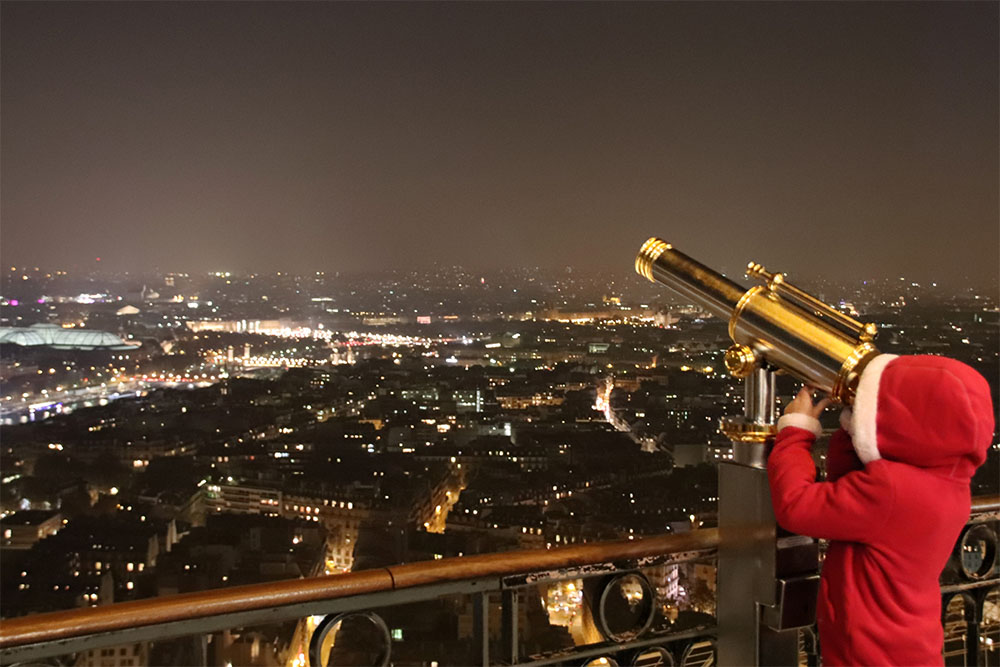
If this was a guide for any other age range we would start talking about features like aperture and magnification and mirrors vs lenses but, to be honest none of those matters too much at this level. The focus at this age should be on learning, safety, and having fun so kids can develop their interest in space.
To pick a good telescope for your five years old here are the considerations you must take into account.
Learning curve: How long do you want the telescope to be useful? Toy telescopes might be better for entertainment purposes but they will only have a useful life of two or three years before they outgrow them. A real telescope, on the other hand, will be more useful and it will last longer, but it does have a bit of a learning curve that some kids might not enjoy. You need to assess if the interest of the kid is really into astronomy or is just curiosity about telescopes.
Aperture: If you do decide to go for a real telescope, the most important feature you need to consider is the telescope’s aperture. The aperture is the diameter of the main lens or mirror at the front of the telescope’s body. This defines the amount of light your device can capture and magnify. The simplest rule is “the bigger the better”, but if you want to delve deeper into the details we have a complete aperture guide you can check out.
Telescope type: There are three types of telescopes: refracting, Newtonian, and compound. Without getting into too many details for this age we recommend refracting telescopes because of one single feature. Refracting telescopes have the eyepiece at the end of the body which makes them more accessible for kids as they can use them more comfortably by standing on top of something. Taller children might even be able to reach it without help. The eyepiece in Newtonian telescopes is located higher making it harder to reach so it is not recommended.
Binoculars: The entry-level alternative to telescopes
If you are not familiar with astronomy you might not know telescopes are not the only device that people can use to enjoy the astronomy hobby.
A lot of people who just want to dip their feet into astronomy for the first time and don’t want to invest a lot of money into a highly specced telescope start with only binoculars.
Some binoculars have high enough magnification to be useful for some basic stargazing like watching the Moon, Mars, Venus, meteor showers, comets, and constellation identification. Binoculars that are used in other hobbies like bird-watching can be used for this purpose too.
While there are some really cool binoculars with great lenses and magnification, for children you have to take weight and comfort into account as some of those might be too heavy for them. For this reason, we recommend binoculars with a magnification of 7 to 9. The magnification is the first number you will see listed in the binocular’s specification. For example, 7×42 binoculars have a magnification of 7 times.
Binoculars with a magnification higher than that are harder to handle, weigh a lot more and it is more difficult to keep them focused on something because even the slightest move in your hands can mean losing the object you were watching. If you really want to go for higher magnification, for example, a 12x, an option to avoid this is to get a tripod for them.
Safety considerations
For the most part, telescopes are very safe for kids to use on their own even at an early age.
The only real danger, especially with small children is telling them not to point the telescope directly at the Sun as it can severely hurt their eyes. Some amount of supervision is always a good precaution anyway.
In the case of actual telescopes, they will need help setting up the tripod and if it is too tall, they will need a stable surface to stand on top of in order to use it. Make sure they don’t just climb into any chair or an unstable object because their eyes will be busy watching the sky and they might forget to pay attention to the ground and they could fall.
Telescope recommendations
We have divided our recommendations into four different categories and selected two products for each. This way we can cover telescopes in different price ranges and brands. We have also included a category for binoculars which as mentioned above are also a great entry-level option for beginners and kids.
Note that for most of the products our recommended age will be lower than the manufacturer’s recommended age range. This is based on some experimentation with the products and the reviews of other users that also believe they are ok for younger children.
Best telescope for 5 year old: Ecoo Pro 70mm Astronomy Refractor
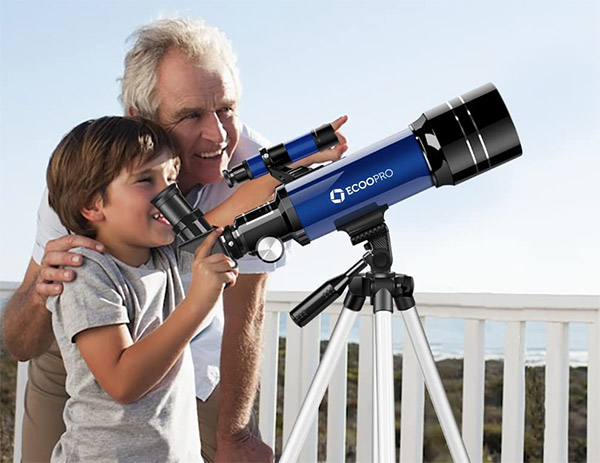
If you are looking for a telescope that is going to last a lot more let’s take a look at some of the options in this space starting with this Ecoo Pro telescope.
This refractor (or refracting) telescope has an aperture of 70mm (2.7 inches) which starts to be enough to capture details in the Moon’s craters and to capture color and patterns in the closer planets instead of just seeing a smudge.
This telescope is specifically designed for children as it requires no tool to set up in the tripod. The included tripod also retracts and is small enough so they can use it comfortably or it can even be made small enough to use it on top of a table. It shouldn’t be too hard to replace the tripod with a bigger one later on.
The company includes two eyepieces in the box. A K10mm and a K25mm with 51x and 128x magnification respectively.
In general, it offers really good value for the price and despite being a small scope it doesn’t make compromises in terms of quality.
Pros
- High-quality lenses
- Easy to setup
- Built specifically with kids in mind
Cons
- Limited optics quality
Recommended age range: 5+ years old
Price:
Best telescope for 4 year old: ACTBOT Telescope for kids
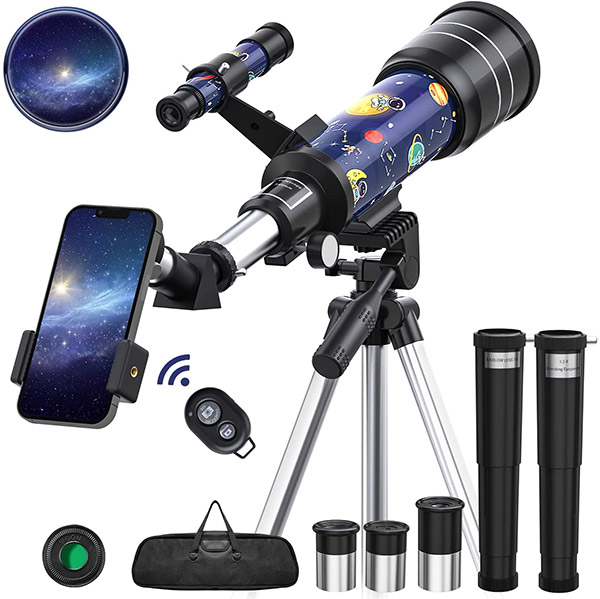
I really like this telescope because not only is it decent enough to get started with astronomy, but it also doubles as a sightseeing scope that you can use during the day for bird watching or similar outdoor activities.
One of the things that are important to consider when choosing a telescope for a kid, is comfort when it comes to the setup and viewing experience. The ACTBOT meets all these requirements because it comes with a small adjustable tripod that a kid can use at a comfortable height, and it also comes with a zenith mirror that fixes the upside-down image refractor telescopes shown by default.
One curious thing about this telescope is that it includes 2 Barlow lenses. These will increase the magnification of the telescope, but they also serve as an extensor for the eyepiece so you can use observe more comfortably from a farther distance. This is something I hadn’t seen before but it makes total sense for a kids’ telescope.
When you add up all the accessories this comes with, you will have a hard time finding a competitor that offers all that value at such a low price. It even comes with a smartphone adapter so you can start taking pictures of the objects that you are observing.
While every kids’ telescope is going to be limited in power because the aperture is not going to be large enough to capture much detail, the 70mm aperture and 360mm focal length of the ACTBOT offer enough power to start looking at the Moon and Mars. Under good conditions, you might get a good view out of Saturn.
Pros:
- Great price-to-value ratio
- Lots of accessories
- IPX7 Waterproof
Cons:
- Build quality could be improved
Recommended age range: 4+ years old
Best telescope for 3 years old: Educational Insights MoonScope
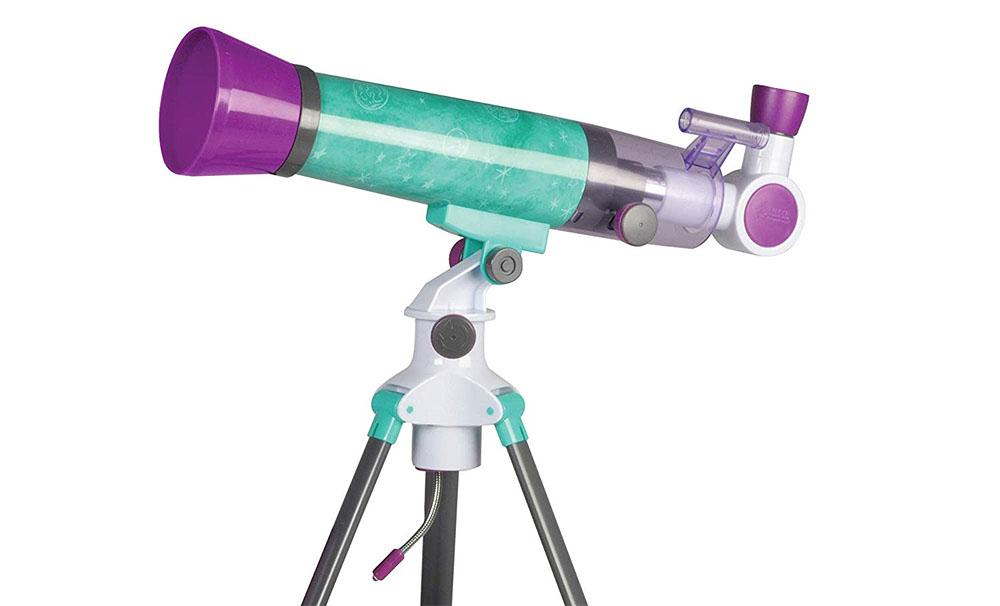
This is the best “toy” telescope you will find out there and probably the only one that has some real capabilities to resemble a telescope so we are putting it first on our list. The MoonScope by Educational Insights is part of the Nancy B’s Science Club line that builds products to introduce children to STEM learning in a fun and interactive manner.
The MoonScope includes two different eyepieces with 18x and 90x magnification and while the lenses are not of the best quality, it should be enough to take a good look at the Moon’s geography and some of the closest planets maybe up to Jupiter. It comes with a tabletop tripod making it light enough to carry around and a 22-page activity book that helps a lot like one of the more common questions asked when getting a telescope for the first time is “now what do I do with it?”.
While it is a great first telescope for younger kids, don’t expect the MoonScope to last for too long as it is still built out of “toy” materials and it doesn’t feel very sturdy.
The manufacturer’s recommended age is 8-11 years old but we believe at that point a more advanced telescope is the way to go and this is just an entry-level product so we are putting it in a lower age range.
The telescope doesn’t require any batteries, but the optional light does.
Pros
- No setup is required, it’s a single piece.
- Multiple eyepieces.
- The activity book is very well done and full of information.
Cons
- The lenses are not high quality
Best telescope for toddlers: Little experimenter telescope for kids

Finding a real telescope with actual magnification for a toddler can be a real challenge. Most toys in this range are really just pretend scopes. The second issue is trying to find something kids can find interesting.
I believe this is the right product.
This telescope has two different functions. It’s a super basic 2x magnification device if you use the viewfinder, but the cool thing about it is it also doubles as a projector that can display 24 different slides related to space and stars. It comes with an educational guidebook that explains what you are looking at so the children can use it as an educational resource.
The viewfinder has a rubber cover so it is comfortable to use, and it is a binoviewer so it’s much easier to use.
It’s a single piece so it doesn’t need any setup, but the tube can be adjusted up and down.
This is more of a toy than a telescope so while it’s okay for looking at animals or maybe the Moon, don’t expect to see any planets with it. If that’s what you want, even when it is for a toddler, look at the options above for older kids.
Pros
- Very comfortable to use
- Highly educational
- 90-day warranty
Cons
- The “telescope” part is very limited
Best binoculars for kids for astronomy: Nikon Prostaff 7S 8×42
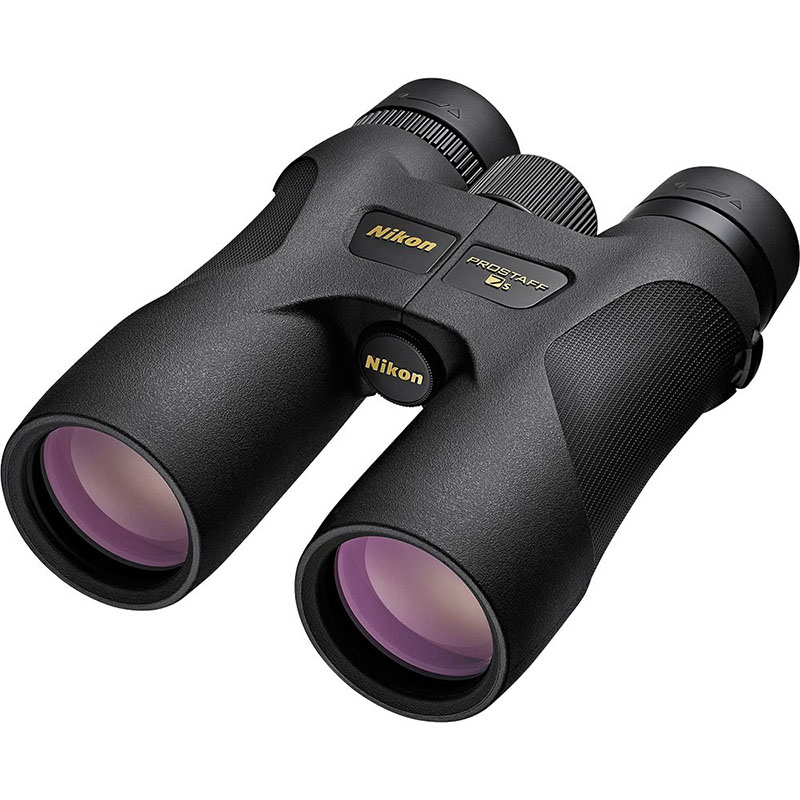
As mentioned above, binoculars can sometimes be a reasonable choice for beginner stargazers. For this recommendation, we are choosing a very high-quality product that will last you for a long time. While the Prostaff 7S are not specifically designed for kids they are small enough that they should be able to use them without much problem with a bit of adult supervision.
With an 8x magnification lens and 42mm aperture, the Nikon Prostaff is surprisingly powerful for binoculars. Nikon is one of the world’s leading companies when it comes to DSLR cameras so they know what they are doing when it comes to lenses and optics. The model is also waterproof and fog proof so it’s ok to bring them camping with you.
On top of the usual accessories you can expect like the lens covers, the Prostaff also comes with its own cleaning kit and a really cool smartphone adapter you can use to plug in your phone and capture photos with it. Using a tripod is recommended if you plan to use that or the photos might be too blurry if you handshakes at that level of magnification.
These binos also come in 10×30 and 10×42 models. While those have better optics they might be too big and heavy for small children so we recommend that you stick with the 8×42.
Pros
- Great optics
- Smartphone adapter and cleaning kit included
- Waterproof is always a good feature when it comes to products kids will use
Cons
- Limited aperture but that’s to be expected from any binoculars







